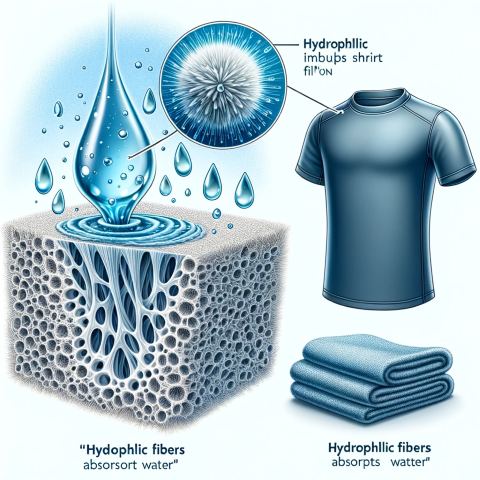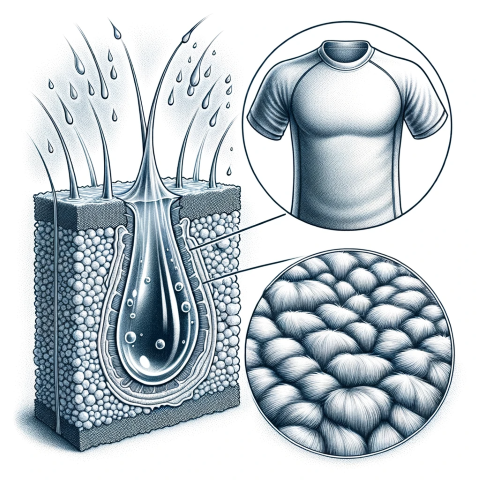What are "Hydrophilic Fibers" - Definition & Explanation
Last Updated on: 08-Apr-2023 (1 year, 18 days ago)
Share on Facebook • Share on Twitter
Last Updated on: 08-Apr-2023 (1 year, 18 days ago)
Share on Facebook • Share on Twitter
Hydrophilic Fibers
Hydrophilic fibers refer to fibers that can absorb moisture and water, making them useful for textiles that require moisture management, such as athletic and performance wear. Hydrophilic fibers can be natural or synthetic, and their ability to absorb moisture is a result of their chemical composition and physical structure.
Natural hydrophilic fibers include cotton, linen, and wool. Cotton is one of the most commonly used hydrophilic fibers in textiles due to its ability to absorb moisture and release it quickly, making it ideal for warm weather clothing. Linen is another natural hydrophilic fiber that is used in textiles due to its high absorbency and breathability, making it ideal for summer clothing. Wool is also a hydrophilic fiber, but its moisture absorption and release properties are slower than cotton and linen.
Synthetic hydrophilic fibers include polyester, nylon, and rayon. Polyester is a synthetic fiber that is widely used in textiles due to its durability and moisture-wicking properties. Polyester fibers are often blended with other fibers, such as cotton, to improve their moisture management properties. Nylon is another synthetic hydrophilic fiber that is commonly used in athletic wear due to its strength and ability to wick away moisture. Rayon is a semi-synthetic hydrophilic fiber made from wood pulp. It is known for its softness and moisture-wicking properties, making it popular for athletic wear and underwear.
Hydrophilic fibers can be treated with various finishes and coatings to enhance their moisture management properties. For example, moisture-wicking finishes can be applied to textiles made from hydrophilic fibers to improve their ability to wick away moisture. Antimicrobial finishes can also be applied to hydrophilic fibers to prevent the growth of odor-causing bacteria.
The use of hydrophilic fibers is particularly important in the development of performance textiles, such as athletic wear. Performance textiles are designed to enhance the wearer's comfort and performance during physical activity by managing moisture, reducing odor, and providing other benefits. Hydrophilic fibers play a key role in achieving these goals by helping to regulate the wearer's body temperature and keeping them dry and comfortable.
Hydrophilic fibers are also used in other applications, such as medical textiles and home textiles. In medical textiles, hydrophilic fibers are used in wound dressings, surgical gowns, and other products that require high absorbency and moisture management properties. In home textiles, hydrophilic fibers are used in towels, bedding, and other products that require high absorbency and softness.
Some of the top manufacturers of hydrophilic fibers and textiles include DuPont, Invista, Lenzing AG, and Toray Industries. DuPont is a leading manufacturer of synthetic fibers, including polyester, nylon, and spandex, which are commonly used in performance textiles. Invista is another major producer of synthetic fibers, including nylon and spandex. Lenzing AG is a leading producer of cellulosic fibers, including rayon and lyocell, which are known for their softness and moisture-wicking properties. Toray Industries is a Japanese conglomerate that produces a wide range of synthetic fibers, including polyester, nylon, and polypropylene.
In conclusion, hydrophilic fibers are essential components of textiles designed for moisture management, such as performance wear, medical textiles, and home textiles. The use of hydrophilic fibers, both natural and synthetic, is widespread in the textile industry, and their properties can be enhanced through the application of various finishes and coatings. Top manufacturers of hydrophilic fibers and textiles include DuPont, Invista, Lenzing AG, and Toray Industries. As the demand for performance textiles continues to grow, the development of new and innovative hydrophilic fibers will be crucial to meeting the needs of consumers and industries alike.
Natural hydrophilic fibers include cotton, linen, and wool. Cotton is one of the most commonly used hydrophilic fibers in textiles due to its ability to absorb moisture and release it quickly, making it ideal for warm weather clothing. Linen is another natural hydrophilic fiber that is used in textiles due to its high absorbency and breathability, making it ideal for summer clothing. Wool is also a hydrophilic fiber, but its moisture absorption and release properties are slower than cotton and linen.
Synthetic hydrophilic fibers include polyester, nylon, and rayon. Polyester is a synthetic fiber that is widely used in textiles due to its durability and moisture-wicking properties. Polyester fibers are often blended with other fibers, such as cotton, to improve their moisture management properties. Nylon is another synthetic hydrophilic fiber that is commonly used in athletic wear due to its strength and ability to wick away moisture. Rayon is a semi-synthetic hydrophilic fiber made from wood pulp. It is known for its softness and moisture-wicking properties, making it popular for athletic wear and underwear.
Hydrophilic fibers can be treated with various finishes and coatings to enhance their moisture management properties. For example, moisture-wicking finishes can be applied to textiles made from hydrophilic fibers to improve their ability to wick away moisture. Antimicrobial finishes can also be applied to hydrophilic fibers to prevent the growth of odor-causing bacteria.
The use of hydrophilic fibers is particularly important in the development of performance textiles, such as athletic wear. Performance textiles are designed to enhance the wearer's comfort and performance during physical activity by managing moisture, reducing odor, and providing other benefits. Hydrophilic fibers play a key role in achieving these goals by helping to regulate the wearer's body temperature and keeping them dry and comfortable.
Hydrophilic fibers are also used in other applications, such as medical textiles and home textiles. In medical textiles, hydrophilic fibers are used in wound dressings, surgical gowns, and other products that require high absorbency and moisture management properties. In home textiles, hydrophilic fibers are used in towels, bedding, and other products that require high absorbency and softness.
Some of the top manufacturers of hydrophilic fibers and textiles include DuPont, Invista, Lenzing AG, and Toray Industries. DuPont is a leading manufacturer of synthetic fibers, including polyester, nylon, and spandex, which are commonly used in performance textiles. Invista is another major producer of synthetic fibers, including nylon and spandex. Lenzing AG is a leading producer of cellulosic fibers, including rayon and lyocell, which are known for their softness and moisture-wicking properties. Toray Industries is a Japanese conglomerate that produces a wide range of synthetic fibers, including polyester, nylon, and polypropylene.
In conclusion, hydrophilic fibers are essential components of textiles designed for moisture management, such as performance wear, medical textiles, and home textiles. The use of hydrophilic fibers, both natural and synthetic, is widespread in the textile industry, and their properties can be enhanced through the application of various finishes and coatings. Top manufacturers of hydrophilic fibers and textiles include DuPont, Invista, Lenzing AG, and Toray Industries. As the demand for performance textiles continues to grow, the development of new and innovative hydrophilic fibers will be crucial to meeting the needs of consumers and industries alike.
Hydrophilic Fibers
Fibers that absorb water easily, take longer to dry, and require more ironing. These fibers denote a finish that improves wearing comfort.
Fibers that absorb water easily, take longer to dry, and require more ironing. These fibers denote a finish that improves wearing comfort.
Hydrophilic Fibers
�Fibers that absorb water easily, take longer to dry, and require more ironing. Hydrophobic Fibers - Fibers that lack the ability to absorb water.
�Fibers that absorb water easily, take longer to dry, and require more ironing. Hydrophobic Fibers - Fibers that lack the ability to absorb water.
Hydrophilic Fibers
Fibers that absorb water easily, take longer to dry, and require more ironing.
Fibers that absorb water easily, take longer to dry, and require more ironing.
Some other terms
Some more terms:
Usually a fluorochemical custom soil-resistant fabric treatment for upholstered furniture. The fabric treatment is odorless and does not affect the feel of a fabric. What it does is increase the...
Tencel
45
A cellulosic fiber produced by Courtaulds, spun from an amine oxide solvent that offers a higher degree of polymerization than is available with rayon. Characteristics: pleasant feel or hand, good...
Purse
97
A purse (also known as a handbag) is a small bag used to hold various small items, such as keys, a wallet, tissues, makeup, a hairbrush, pepper spray, and/or a gun (though it is generally recommended...
Axminster
67
A type of carpet where the pile is inserted one row of tufts at a time, each row representing a section of the overall pattern. The tufts are `U'-shaped, and are anchored at the bottom into the...
Plisse
43
A fabric with a crinkied or puckered affect, generally in the direction to the warp, which is created either by tension weaving or through the application of a caustic soda solution which shrinks...
Add a definition
Add a definition for a textile term that you know about! Send us an email & tell us:
- The term you want to define
- Its definition in 500 words or less
- Attach an image if necessary.
- Optionally, tell us about yourself in 200 words or less!
Companies for Hydrophilic Fibers:
If you manufacture, distribute or otherwise deal in Hydrophilic Fibers, please fill your company details below so that we can list your company for FREE! Send us the following details:
- Company name
- Company address
- Attach a logo, if necessary.
- Optionally, tell us about yourself in 200 words or less!
(s) 2024 TextileGlossary.com Some rights reserved. • Sitemap

